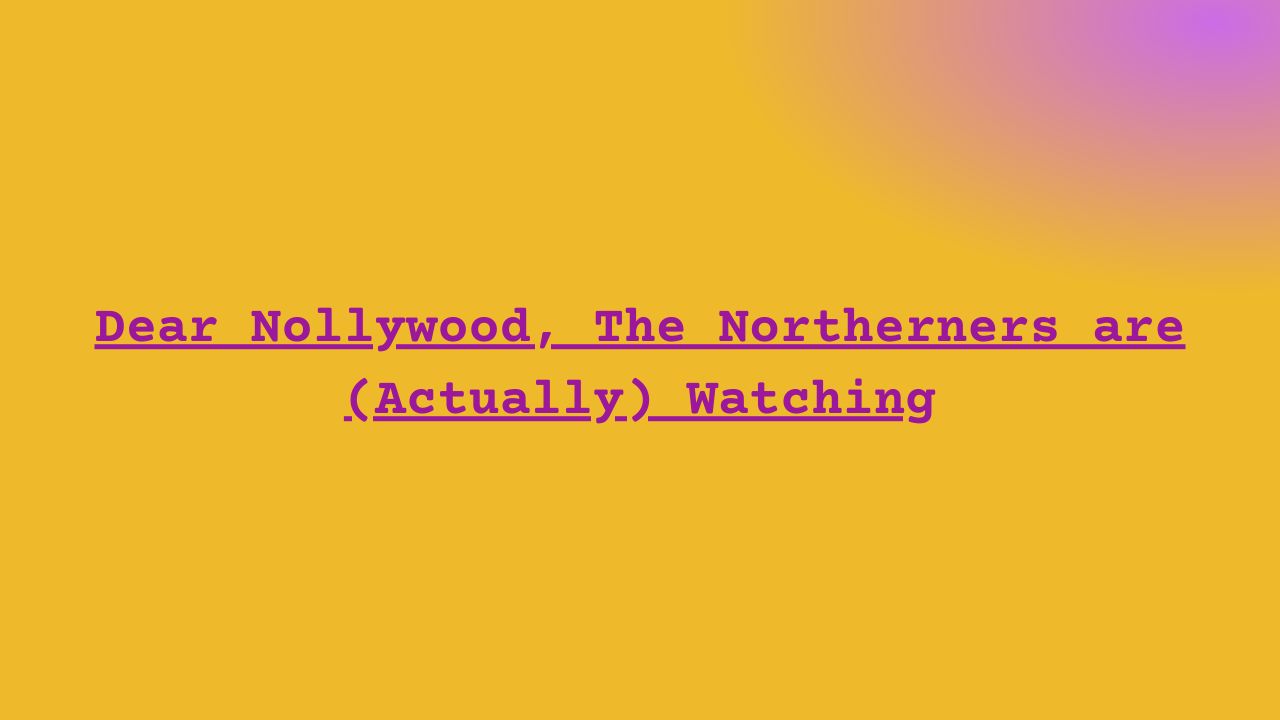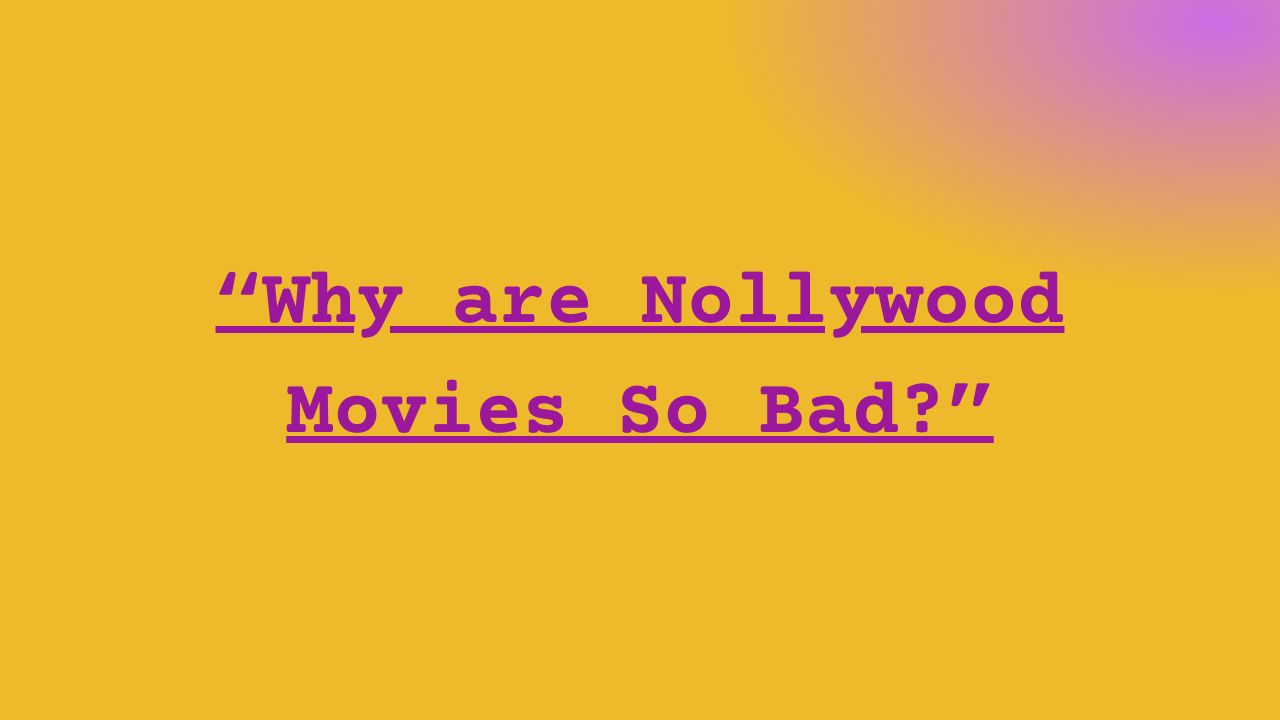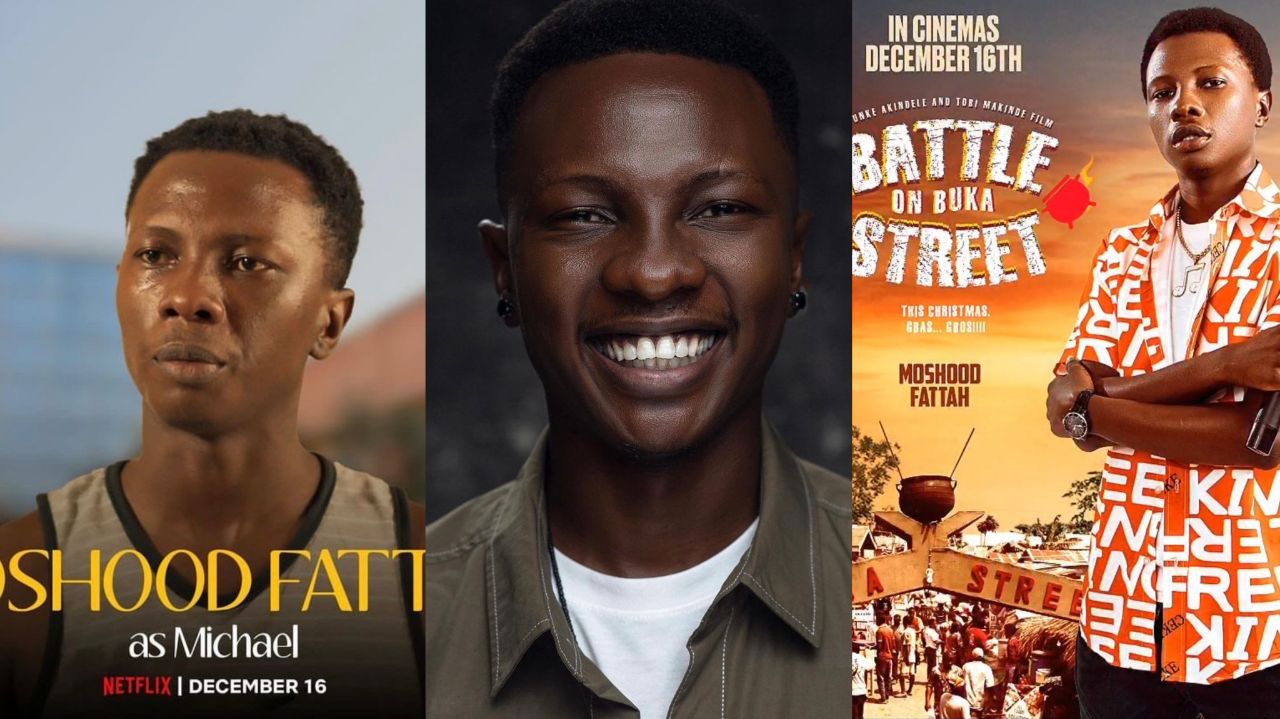Nollywood is a cultural phenomenon and no doubt one of the most enduring ones of the 21st century. Like other industries, through the decades, it has had to adapt to various societal shifts and technological advancements, continuously changing to survive, to push the needle of creativity forward, as well as turn a handsome profit– it still is a business after all. On that front, things have never been better. Now the second largest film industry in the world by output, churning out over 2,500 films annually, Nigeria’s film industry contributed 2.3% (about N239 billion, or $660 million) to its Gross Domestic Product in 2021. That same year, it employed close to 300,000 workers, the highest in five years. All the projections for the future indicate that this path only shines brighter. So, why do critics and audiences, both at home and abroad, regularly lament their dissatisfaction with a good number of these films? Why does it feel like while more money is being invested, the ball is being dropped, as far as creativity and artistry are concerned?
Things feel like they’re in stasis, as if a plateau has been reached where we’ve elected to pitch our tents and set up shop. A fellow critic said to me last year, “I am tired of saying the same thing in different ways,” referring to how their reviews of virtually every Nollywood project released had come to feel like flogging a rigor-mortised horse; for them, the diagnosis of the problem with one movie or TV show was almost always the same as the next: a severe lack of coherence among all filmmaking elements. Not that the filmmakers aren’t trying. Across the industry, thousands of people are at work, attempting to better their craft through any means possible, which proves an uphill task given the disadvantages that come with being a Nigerian in Nigeria. Still, these autodidacts merely symptomize the deeper issues: the lack of proper and adequate film education in the country, the absence of a vibrant film culture in which to partake or take pride, as well as shaky scaffolding where a solid industry structure should be. But I’m getting ahead of myself.
A Brief History
The history of the film industry in Nigeria can be categorized into four eras.
During the Colonial period (1903-1960), the first films screened in Nigeria were at the Glover Memorial Hall in Lagos, from August 12 to 22, 1903. Although the films from this era were not as interested in entertainment as much as they were in propaganda, many people flocked to see documentaries and newsreels, produced by the government and religious organizations alike.
In what is termed the Independence era (1960-1972), notable theater practitioners such as Moses Olaiya (aka Baba Sala) and Hubert Ogunde began their transition to the big screen. The former would go on to release Mosebolatan in 1985, a box office success which grossed about N107,000.00 in five days.
In 1972, the Nigerian Enterprises Promotion Decree enabled more Nigerians to be involved in cinema exhibition and distribution. However, this period of boom, both for oil and cinema, eventually dwindled. Celluloid had become a lot more expensive than video, which was quickly gaining popularity. Before 1999, all the major cinemas in Lagos had closed down.
The stage was set for Nollywood as we knew it in the early 2000s to come into effect. And though there is a lot of controversy surrounding the name, it first appeared in a 2002 New York Times article by Norimitsu Onishi, who used it to describe the feeling of hanging out in Surulere where filmmakers were “busy shooting on every street corner, frantically churning out what were then called ‘home videos’”, a trend that didn’t begin with 1992’s Living in Bondage but was nonetheless popularized by it. Apparently, ‘Nollywood’, refers to ‘nothing wood’, as in the process of creating something out of nothing. According to Charles Igwe, CEO of Nollywood Global Media Group, “a medical doctor friend of mine, in describing his experience of our filmmaking activities, likens it to performing open-heart surgery with forks and knives, but the genius of it all is that the patient survives.”
The state of things in the industry right now is one where a lot of the major players seem to have not only accepted this forks-and-knives way of doing surgery but also come to revel in it. Yes, it is commendable and nothing short of miraculous that Nollywood has gotten this far, despite all odds and oddities, and I have and will continue to sing the praises of our hits (and our misses) at every opportunity. However, an industry cannot soar on the wings of its outliers alone. Like several film industries abroad, we have clawed our way to prominence. Yet, if we fail to have real conversations about how to move forward, and how to create a structure that enables things to operate more smoothly, we risk the deterioration of all the success so far.
The Present
One recurring critique of a lot of Nollywood films is that the stories fail to add up somehow. This issue is further illustrated in the characterization, plot, and dialogue; there’s usually a sense of the story feeling incomplete, either because the promise of the premise is not delivered on, or the storytelling is inauthentic and insincere, choosing to fall to tired tropes rather than aim for the specificity of the Nigerian condition. This is not to say that these problems are not present elsewhere. Even Hollywood seems to have, in recent years, lost sight of the importance of screenwriting to the art and business of filmmaking. Apart from certain exceptions, a work of narrative film lives and dies by its screenplay. If there’s no meat within those pages, then there’s nothing for the actors or directors to chew on, nothing to interpret. You’d have to try to ruin a good screenplay, while a bad one would require tons of work to beat into shape.
Here’s a quote from Mexican filmmaker, Alfonso Cuaron, speaking at Cannes about his 1998 film, Great Expectations. He stresses the significance of a good screenplay, saying: “I had said no three times, but I became cocky. I said, ‘Okay, I don’t like this script, but we’re going to compensate visually.’ That never works. When the essence—the concept, the soul—isn’t there, you can’t compensate with anything. That is the truth of the matter…I did the wrong film. I should not have done it. I didn’t know what I was doing.”
And yet, given just how important screenwriting is to the film production process, it is baffling that more time is not being invested in this aspect, especially by the major players. Not everyone who is involved with making movies can automatically become a screenwriter, and frankly, not everyone should. The craft is frequently described as deceptively hard to master. Even the great American writer F. Scott Fitzgerald couldn’t cut it in Hollywood, because writing scripts requires a lot more than being a literary genius. Not all films can afford to have their screenplays penned down in one weekend. Some will require months and months of story development, collaboration, and scores of discarded drafts.
Of course, a lot of Nollywood bigwigs know this. Their counterargument is usually that “people need to eat” and the industry needs to ensure production time is as short as possible. For that reason they cannot dedicate that much time to story development and writing, knowing that the audience will watch whatever they churn out anyway, evidenced by the occasional favorable box office returns—once again, outliers. Granted. However, “people need to eat” is not a sustainable way to run an industry. Filmmakers have a responsibility to the public, to not serve them regurgitations of overused tropes, but fresh stories that not only entertain but also inform and challenge their views– kudos to the filmmakers in the industry who have found a way to consistently do just that. To think it impossible to routinely do all these in a film and still make a lot of money implies a lack of vision and a severe misunderstanding of the purpose as well as the capacity of narrative cinema.
According to an anonymous Nollywood producer, “The problem [with story in particular and the quality of filmmaking overall] starts from the top, [from] the EP/Producer. They use our favorite actors to mask their mediocrity. They believe that once the audience loves certain actors, they’ll be very biased regardless of the story. If we can get it right from this stage, every other person will fall in place.” Producers are meant to facilitate and organize the entire film production process, instead of merely acting as the bankrollers.
Steven Soderbergh (Ocean’s 11) once said: “Cinema is a specificity of vision. It’s an approach in which everything matters. It’s the polar opposite of generic or arbitrary and the result is as unique as a signature or a fingerprint. It isn’t made by a committee, and it isn’t made by a company, and it isn’t made by the audience.” A lot of the directing we see in mainstream Nollywood runs afoul of this sentiment.
Let’s examine acting, one department in Nollywood that has remained consistently filled with talents awaiting the script/project to push them. The problem with acting in Nollywood begins with the executive producers and is also tied to the distributors; it’s essentially a Mobius strip situation. Certain actors and internet stars are thrown in front of our faces repeatedly. Whether or not they are fit for the role(s) seems to take a backseat to their bankability and brand recognition. Most of the time, throwing all the famous people you can afford into a two-hour film will not give you much acclaim with audiences. Sometimes, it will even fail to make you as much money as you’d hoped.
Here, we can begin to understand the “lack of coherence between filmmaking elements” my colleague talked about. When to curry favor with distributors, producers fill their films with people who either cannot act well, or are unfit for the role, and the underpaid screenwriter is under pressure to churn out a screenplay before moving on to the next one, and the directors and cinematographers deliver a project that for the most part is generic and arbitrary, what can we expect but a slew of films that are as put-together as the wall of Jericho, post-fall?
A lot of these issues also stem from why we produce films in the first place.
 Dear Nollywood, The Northerners are (Actually) Watching
Dear Nollywood, The Northerners are (Actually) Watching
 How Nollywood Can Preserve Romcoms Like Kdramas
How Nollywood Can Preserve Romcoms Like Kdramas
Why is Cinema?
Cinema is the 7th art, a 19th-century innovation that exists at the intersection of storytelling and technology, a tool that many corporations around the world have made all about profit maximization. Not that there’s anything remotely wrong with making money. However, if that is the extent of our film philosophy (i.e. cinema as a means to a buck), then the works we produce run the risk of being soulless and inert, capable of nothing more than fleeting entertainment.
Walt Disney once said, “We don’t make movies to make money. We make money to make more movies.” So, we have to ask ourselves, are films just about making money, or selling a product? Or can they be more? Does film not also have the capacity to mediate our experience of the world, our culture, politics, history, and emotions? According to Andrei Tarkovsky, “Relating a person to the whole world: that is the meaning of cinema.” I agree.
In 3 Idiots, a film overflowing with quotable quotes, this is hands down my favorite one: “Pursue excellence, and success will follow, pants down.” If we focus on creating a structure that helps us maximize not just profit, but excellence in our storytelling, then there is no reason Nollywood cannot become as critically revered around the world as the Cinema of Iran or the Korean film industry.
I say all of this even though I realize that I need to cut the industry some slack, as we haven’t had as much time to develop compared to our counterparts, and the major reason we continue to approach filmmaking with an entrepreneurial mindset is that film tends to be a capital and labor intensive medium. Still, all hope is not lost. One country I like to consider as a prime example of how to cultivate a solid, homegrown cinema is Taiwan.
The Taiwanese New Wave came about partly in response to the growing dominance of Hong Kong films in the country. A new crop of filmmakers, such as Edward Yang, Ang Lee, and Tsai Ming-Liang (whose styles inspired the Esiri brothers’ debut, Eyimofe), chose to focus on social realism rather than formalism (because they couldn’t compete with Hollywood or Hong Kong on that front), and in so doing, put the cinema of Taiwan on the map. First, they focused on relaying to their local audience something foreign cinema couldn’t give them: a nuanced portrayal of ordinary life in Taiwan couched in a sense of empathy and camaraderie. And then the awards and worldwide recognition followed. Nollywood could learn a lot from that. Moving forward, our focus should shift to projects with low or medium budgets. Essentially, we need to learn to run before we can soar like eagles for hours at a time. And like Taiwan, we stand a better chance of developing our craft and industry by focusing less on competing with Bollywood or Hollywood.
Cinema as a Language
Cinema is “…visual Esperanto…a language in itself, comparable to mathematics and music in its universality.”
According to some schools of thought, “…the shot is the word of film, the scene its sentence, and the sequence its paragraph. Punctuations are provided by cuts, wipes, dissolves, fade-ups, fade-downs, superimpositions, etc. Montage or/and image compositions determine the narrative.” As with any language, this implies that cinema has its rules and conventions, and sufficient knowledge of them is necessary to subvert or transcend their boundaries, the same way poetry does for the written word.
This is the part where I focus on our lack of proper cinematic education in Nigeria. Again, several passionate individuals have created film schools and programs for the study of the theory and production of film; however, this cannot compare to a well-established system of training. Although the language of cinema is universal, it still has to be thoroughly studied. A lot of us engage with cinema as a second language, the way a non-native speaker might with say, Swahili. To truly become fluent, we must eat, drink, think, and dream cinema. Given the comparison made between cinema and spoken lanuage, I found the following excerpt particularly insightful:
“A quick look at the statistics though, gives us a good idea why so many people believe that learning languages is hard and only for the gifted. Studies show that only 4% of people who start a language course through a school reach basic fluency after 3 years. This means that 96% either drop out or fail to get to even basic fluency. The thing is that learning a language is not hard, it just takes a very long time. And everyone can do it.”
Cinema is a language of sounds and symbols and all forms of audiovisual shorthand that everyone can learn how to speak fluently. This would be easier if we had a bustling cinema culture in the country, comparable to that of France, for instance– I once heard that their bustling film industry is a product of close ties between academia, criticism, arthouse, and the mainstream. And while we need to put things in place for coming generations of filmmakers and audiences, there is a lot we can begin to change for today, for example, our relationship with film criticism or screenwriting.
The image of Chatur Ramalingam, a highly successful working man, chasing down Rancho and company at the end of 3 Idiots is burned in my brain; success will always follow excellence, especially if all the cards are played right.
Looking to the future, we would do well to focus on stories with simple premises, probably set in as few locations as possible. We can still populate them with our A-listers and veterans while also giving opportunities to new talent. Doing this would enable us to focus more on the characters and themes than on flashy production, glamour, or intercontinental settings.
Not that there’s anything wrong with these. Some of our best films have glamour in spades. However, the mid-budget space is being neglected the world over, especially by Hollywood, whose cinema output now features mostly blockbusters (with budgets of 200 million dollars and above), and the occasional indie film (from Blumhouse, A24, NEON etc). Rather than imitating their blockbuster culture and hoping to hit occasional box office jackpots, We can pitch our tents in the midbudget space and begin to experiment with ideas, styles, and marketing strategies, cultivating a cinema we can truly be proud of.
To revisit the forks-and-knives analogy, even if you heard that a surgeon has had a high success rate by performing his operations with cutlery, you’d still be hesitant to get on the operating table, no matter how much convincing is attempted on their part. I reckon it’s high time we switched to scalpels and hand forceps because we are guaranteed a better outcome by operating within the right system and using the right tools.
Share your thoughts in the comments section or on our social media accounts.
Sign Up: Keep track of upcoming films and TV shows with Google Calendar.






2 Comments